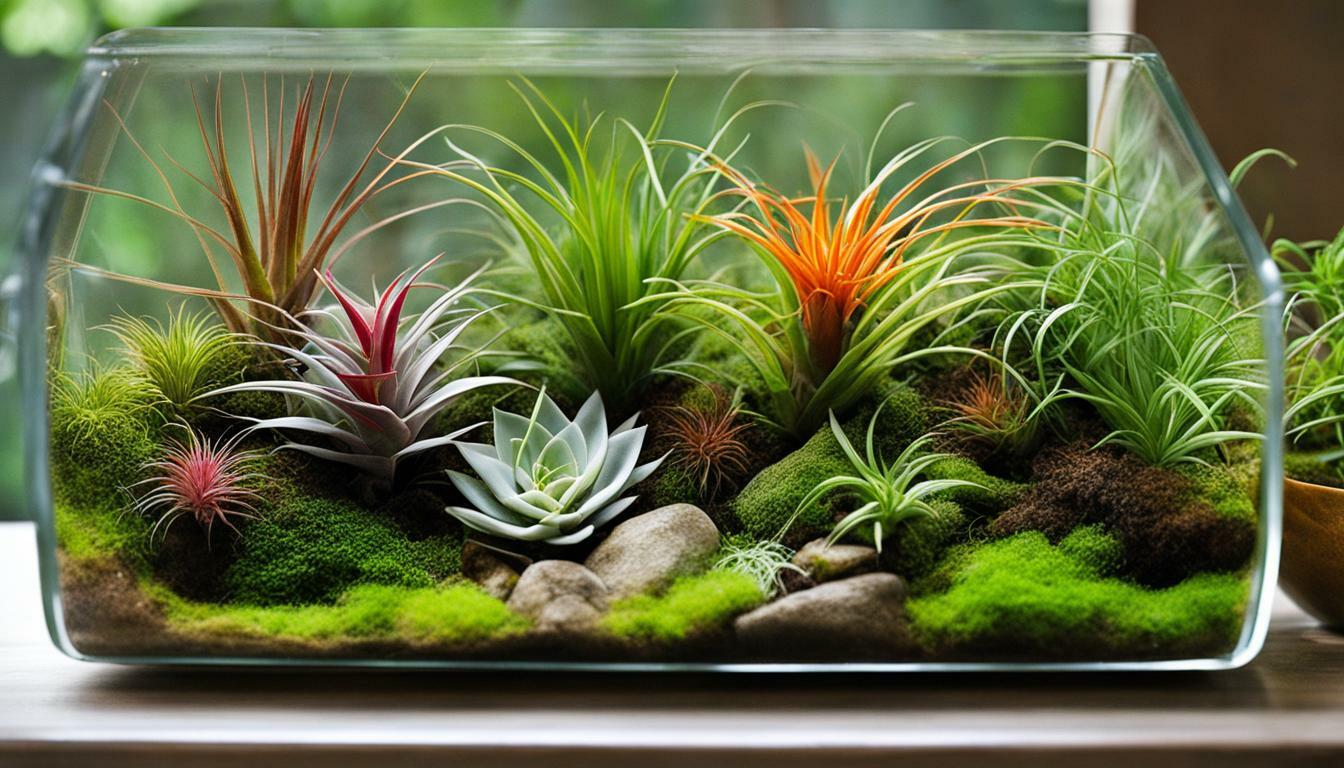Welcome to our comprehensive guide on terrarium plants, specifically focusing on the essentials of Tillandsia air plants for creating lush and thriving indoor ecosystems. Terrariums are a wonderful way to bring nature into your home and create a captivating display of greenery. Tillandsia air plants, also known as air plants, are a popular choice for terrariums due to their low-maintenance nature and unique aesthetic.
- Tillandsia air plants are ideal for terrariums due to their low-maintenance nature.
- When choosing air plants for your terrarium, select species that stay small.
- Air plants require a glass container with good airflow and clear glass for maximum light exposure.
- The base of the terrarium can be made with materials like sand, gravel, or moss.
- Enhance the aesthetic of your terrarium with decorative elements like driftwood, shells, or crystals.
Creating a terrarium with Tillandsia air plants is an enjoyable and rewarding experience. Throughout this guide, we will explore the various aspects of selecting, designing, and caring for air plants in a terrarium. From choosing the right air plants to enhancing the overall aesthetic, we will provide you with the essential knowledge and tips to create a stunning terrarium that will thrive in any indoor environment.
Choosing the Right Air Plants for Terrariums
When creating a terrarium with air plants, it’s crucial to choose the right species that can thrive in the enclosed environment. Opt for air plants that are known for their easy care requirements and consider incorporating unique varieties for an added touch of visual appeal.
Air plants that are ideal for terrariums are those that stay small and require minimal care. Species such as Tillandsia Ionantha or Tillandsia Mexican are popular choices due to their compact size and ability to thrive in the low-light conditions typically found in terrariums. These plants are known for their resilience and can adapt to a variety of environments, making them perfect for beginners or those with busy schedules.
Air Plants for Terrariums
| Plant Species | Light Requirements | Watering Needs | Growth Size |
|---|---|---|---|
| Tillandsia Ionantha | Medium to bright indirect light | Mist or soak once a week | Up to 4 inches tall |
| Tillandsia Mexican | Low to medium indirect light | Mist or soak every two weeks | Up to 6 inches tall |
When choosing air plants for your terrarium, consider the lighting conditions in the area where the terrarium will be placed. If you have a bright, sunny spot, opt for air plants that can thrive in those conditions. If the area has lower light levels, choose species that are more tolerant of shade.
Additionally, it’s worth considering the overall design and aesthetic you want to achieve with your terrarium. There are countless unique air plant varieties available, ranging from vibrant colors to interesting shapes. Incorporating these unique varieties can add visual interest to your terrarium and create a truly one-of-a-kind display.
By selecting air plants known for their easy care requirements and incorporating unique varieties, you can create a beautiful and low-maintenance terrarium that brings a touch of nature into your indoor space.
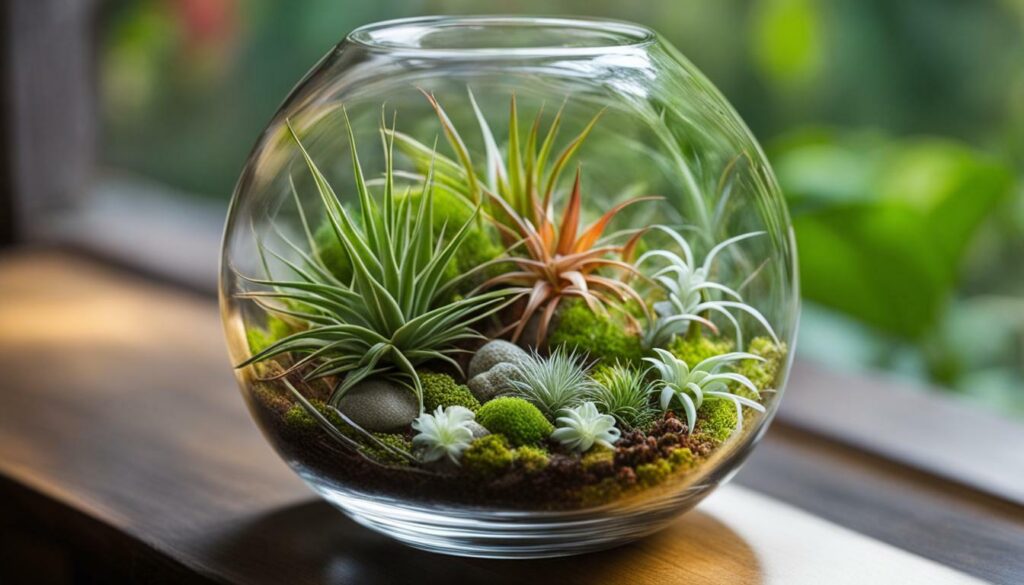
Designing a terrarium for air plants involves careful consideration of the container’s airflow and light penetration, as well as incorporating decorative elements for an aesthetically pleasing display of low-maintenance terrarium plants. An ideal terrarium container is made of glass, allowing for maximum light exposure to promote healthy plant growth. The container should also have good airflow, which can be achieved through the use of vents or gaps in the lid or sides of the terrarium. This ensures that the air plants receive proper ventilation, preventing the buildup of excess moisture that can lead to rot.
When it comes to decorating the terrarium, there are various options to enhance its visual appeal. Decorative air plants, such as Tillandsia xerographica with its striking rosette shape or Tillandsia bulbosa with its unique curly leaves, can add a touch of elegance and intrigue to the terrarium. Additionally, incorporating natural elements like driftwood, seashells, or crystals can create a captivating landscape within the terrarium. These decorative elements not only provide visual interest but also serve as perches or support structures for the air plants.
To create a balanced and harmonious design, it is important to consider the size, shape, and color of both the air plants and the decorative elements. Mixing different textures and heights can add depth and dimension to the terrarium. For example, pairing a tall Tillandsia xerographica with a delicate piece of driftwood can create an eye-catching focal point. It is essential to arrange the plants and decorations in a way that creates an aesthetically pleasing composition, taking into account the growth habits and desired visual impact of each element.
| Design Tips for Terrariums |
|---|
| Choose a glass container with good airflow and clear glass for maximum light exposure. |
| Select decorative air plants, such as Tillandsia xerographica or Tillandsia bulbosa, to add visual interest. |
| Incorporate natural elements like driftwood, seashells, or crystals for a captivating landscape. |
| Consider the size, shape, and color of both the air plants and the decorative elements for a balanced design. |
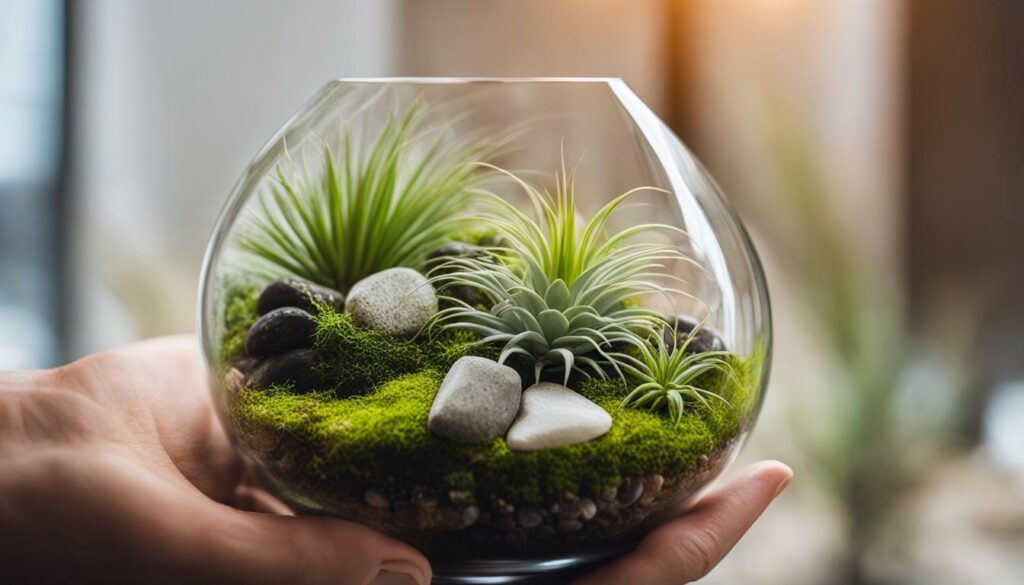
With careful thought and attention to detail, designing a terrarium for air plants can be a rewarding and creative endeavor. By creating an environment that allows for proper airflow, light penetration, and incorporating decorative elements, you can showcase the beauty of low-maintenance terrarium plants while adding a touch of elegance to your living space.
Creating the Terrarium Base
The base of a terrarium provides the foundation for your Tillandsia air plant collection, and selecting the right materials, such as sand, gravel, or moss, can ensure optimal growth and a visually appealing display with complementary plants for terrariums. Sand is a popular choice for the base as it provides drainage and stability. You can choose fine sand for a smoother look or opt for coarse sand to create a more textured base. Gravel is another option that not only adds visual interest but also aids in drainage. Moss can be used as an alternative or in combination with sand or gravel to create a natural-looking base. It helps retain moisture and adds a lush, organic feel to the terrarium.
When creating the base, consider the size of your air plants and the overall design of the terrarium. If you have larger air plants, like Tillandsia xerinantha, you may need a deeper base to support their size. On the other hand, smaller air plants, such as the Tillandsia bulbosa, may require a shallower base. Experiment with different combinations of materials to find the best fit for your terrarium.
“The base of the terrarium is like the canvas on which your air plants will come to life. Choose materials that not only support their growth but also enhance the overall aesthetic. Sand, gravel, and moss are versatile options that can be used alone or in combination to create a stunning base for your Tillandsia air plant collection.”
As you create the base, remember to consider the needs of your Tillandsia air plants. These plants are epiphytes, which means they don’t require soil to thrive. Instead, they absorb moisture and nutrients through their leaves. The base should provide stability and support for the air plants while allowing them to access the air and light they need to thrive. Avoid overcrowding the base with too many plants, as this can restrict airflow and hinder their growth.
Table:
| Materials | Description |
|---|---|
| Sand | Provides drainage and stability, available in fine or coarse textures. |
| Gravel | Adds visual interest and aids in drainage. |
| Moss | Retains moisture and adds a natural look to the terrarium. |
By carefully selecting the right materials for the base of your terrarium, you can create an environment that not only supports the growth of your Tillandsia air plant collection but also enhances the overall beauty of the display. Experiment with different combinations and designs to find the perfect balance that suits your style and allows your air plants to thrive.
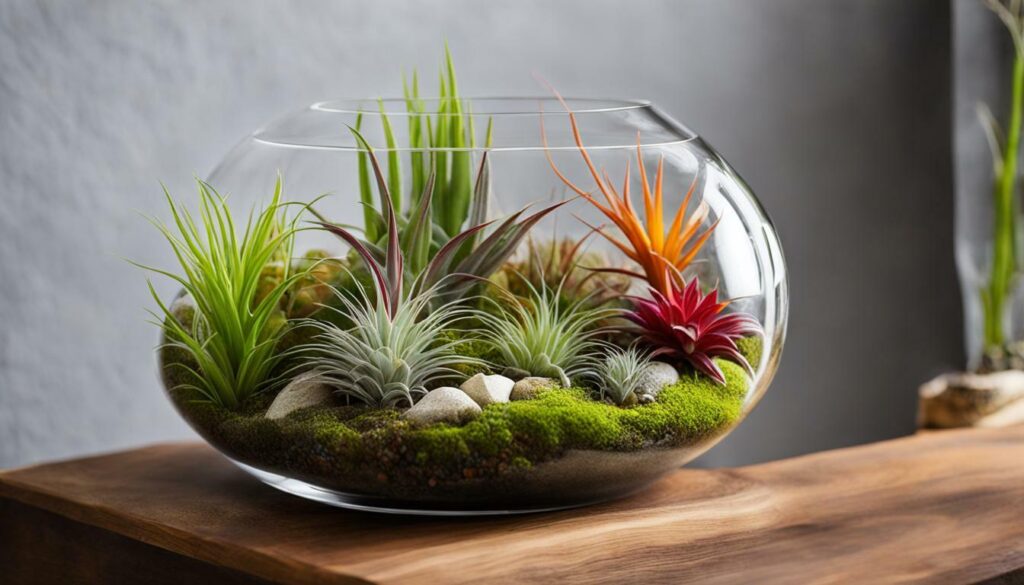
Elevate the visual appeal of your terrarium by incorporating unique terrarium plants and adding decorative air plants, such as driftwood, shells, or crystals, to create a customized and aesthetically pleasing display. Terrariums provide the perfect opportunity to showcase a variety of plant species that are not only visually stunning but also thrive in the enclosed environment.
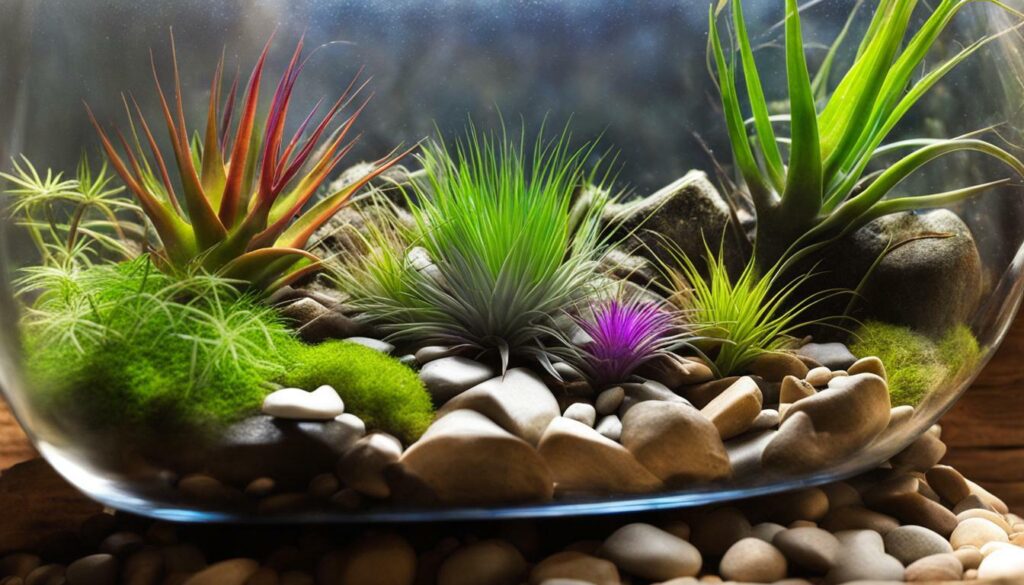
One way to enhance the aesthetic of your terrarium is by selecting unique terrarium plants. These can include plants with interesting foliage patterns, vibrant colors, or unusual shapes. Some popular choices include the striking Tillandsia xerographica with its silvery-gray leaves, the intricate and colorful Tillandsia bulbosa, or the delicate Spanish moss (Tillandsia usneoides) that drapes gracefully from branches or rocks.
“The beauty of a terrarium lies in its ability to create a miniaturized world. By incorporating unique terrarium plants, you can create a captivating and enchanting display that will be a true conversation starter.”
Decorative air plants can also play a crucial role in enhancing the terrarium aesthetic. They can be attached to pieces of driftwood, nestled among seashells, or clustered around crystals to create a stunning visual focal point. These decorative elements not only add visual interest but also provide texture and dimension to the terrarium environment, making it truly unique.
Table: Unique Terrarium Plants and Their Characteristics
| Plant | Characteristics |
|---|---|
| Tillandsia xerographica | Silvery-gray leaves, large rosette shape |
| Tillandsia bulbosa | Colorful, curly leaves with a bulbous base |
| Tillandsia usneoides | Delicate, trailing Spanish moss |
Adding unique terrarium plants and decorative air plants to your terrarium will not only create a visually stunning display but also provide an opportunity for creativity and personalization. Experiment with different combinations and arrangements to find the perfect balance that suits your style and preferences.
Proper Placement and Securing of Air Plants
Proper placement and secure positioning of air plants within a terrarium is crucial for their growth and overall health, especially when dealing with delicate species like Tillandsia air plants. These unique plants rely on air and moisture for their survival, so creating an environment that mimics their natural habitat is essential.
When placing air plants in a terrarium, it is important to avoid overcrowding. Leave enough space between each plant to allow for proper airflow and light exposure. This will help prevent the buildup of excess moisture, which can lead to rot or fungal diseases.
To secure the air plants in place, you can use glue or wire if necessary. Be careful when handling the plants, as their delicate structure can easily be damaged. Gently attach them to decorative elements, such as driftwood or rocks, ensuring they are securely positioned but not squeezed too tightly.
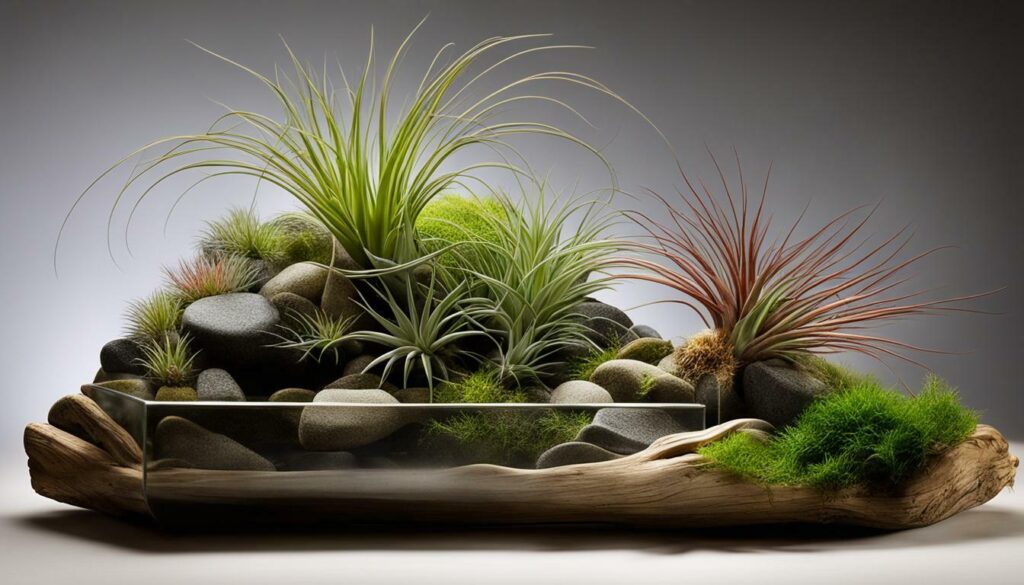
Remember to consider the specific needs of Tillandsia air plants when deciding on their placement. Some species prefer bright, indirect light, while others can tolerate lower light conditions. Take into account the temperature, humidity, and airflow of your terrarium to provide an optimal environment for their growth.
By taking the time to properly place and secure your air plants within the terrarium, you can create an attractive display while ensuring their well-being. Observing their growth and making any necessary adjustments will help you maintain a thriving terrarium filled with beautiful Tillandsia air plants.
| Terrarium Placement Tips | |
|---|---|
| Consider plant size: | Avoid overcrowding and allow for proper airflow and light exposure. |
| Secure plants delicately: | Use glue or wire to safely attach air plants to decorative elements. |
| Optimize the environment: | Take into account factors like light, temperature, humidity, and airflow. |
| Monitor and adjust: | Observe the plants’ growth and make any necessary changes to their placement or care. |
Care and Maintenance of Air Plants
Keeping your air plants healthy and thriving in a terrarium requires regular misting or soaking for hydration and monthly fertilization, especially when caring for a diverse Tillandsia air plant collection. These low-maintenance terrarium plants rely on air and moisture to survive, making proper care essential.
When it comes to watering air plants, there are two main methods: misting and soaking. Misting involves lightly spraying the plants with water using a spray bottle, ensuring that each plant receives a fine mist. Soaking, on the other hand, involves fully submerging the air plants in water for 20-30 minutes, allowing them to absorb moisture through their leaves. Misting should be done 2-3 times a week, while soaking should be done once a week.
In addition to watering, air plants also benefit from monthly fertilization. Using a balanced, water-soluble fertilizer specifically formulated for air plants, dilute it to half the recommended strength and apply it to the plants during their regular watering routine. Fertilizing once a month helps provide essential nutrients that support their growth and overall health.
It is important to monitor the condition of your air plants regularly. Check for any signs of pest infestations, such as mealybugs or scale insects, and take immediate action to address the issue. Isolate affected plants to prevent the infestation from spreading to other plants in the terrarium. Regularly inspect the leaves for any signs of damage or discoloration, and remove dead or damaged leaves to maintain the overall health and appearance of the air plants.
By following these care guidelines, your air plants will thrive in the terrarium environment, adding beauty and greenery to your indoor space. Remember to provide them with the proper amount of water, regular fertilization, and monitor their overall health to ensure they continue to flourish.
| Step | Frequency | Method |
|---|---|---|
| Watering | Misting: 2-3 times a week Soaking: Once a week | Mist plants lightly or fully submerge in water for 20-30 minutes |
| Fertilizing | Once a month | Dilute balanced water-soluble fertilizer for air plants and apply during regular watering |
| Pest Monitoring | Regularly | Inspect for signs of pests, isolate affected plants, and take appropriate measures |
| Leaf Maintenance | Regularly | Remove dead or damaged leaves to maintain overall plant health |
Propagation and Growth of Air Plants
Learn the art of propagating and growing air plants in your terrarium by separating the offshoots or pups that develop at the base of Tillandsia air plants, and discover their growth patterns and distinctive traits that make them ideal plants for terrariums.
Propagation is an exciting and rewarding process that allows you to expand your collection of air plants and create a lush, green oasis in your terrarium. To propagate air plants, carefully separate the offshoots or pups that have grown at the base of the parent plant. Gently twist or pull them away, ensuring that each pup has a healthy root system attached.
After separating the pups, you can place them directly in your terrarium or in a separate container filled with a well-draining medium, such as coarse sand or orchid bark. Mist the pups regularly and provide them with bright, indirect light to promote healthy growth. In just a few weeks, you will begin to see new leaves forming and roots developing.
Tillandsia air plants are known for their unique growth patterns and characteristics. Some species, like the Tillandsia Ionantha, feature vibrant colors that intensify when they bloom. Others, such as the Tillandsia xerographica, have a striking rosette shape with feathery leaves that curl gracefully. With their adaptability and ability to thrive in terrarium environments, these air plants are considered the best plants for terrariums.
| Air Plant Species | Growth Pattern | Distinctive Traits |
|---|---|---|
| Tillandsia Ionantha | Clumping | Vibrant colors when blooming |
| Tillandsia xerographica | Rosette | Graceful, curling leaves |
| Tillandsia bulbosa | Curly and branching | Pom-pom-like appearance |
With knowledge of the propagation process and an understanding of the unique growth patterns and traits of Tillandsia air plants, you can create a thriving terrarium filled with these beautiful and low-maintenance plants.
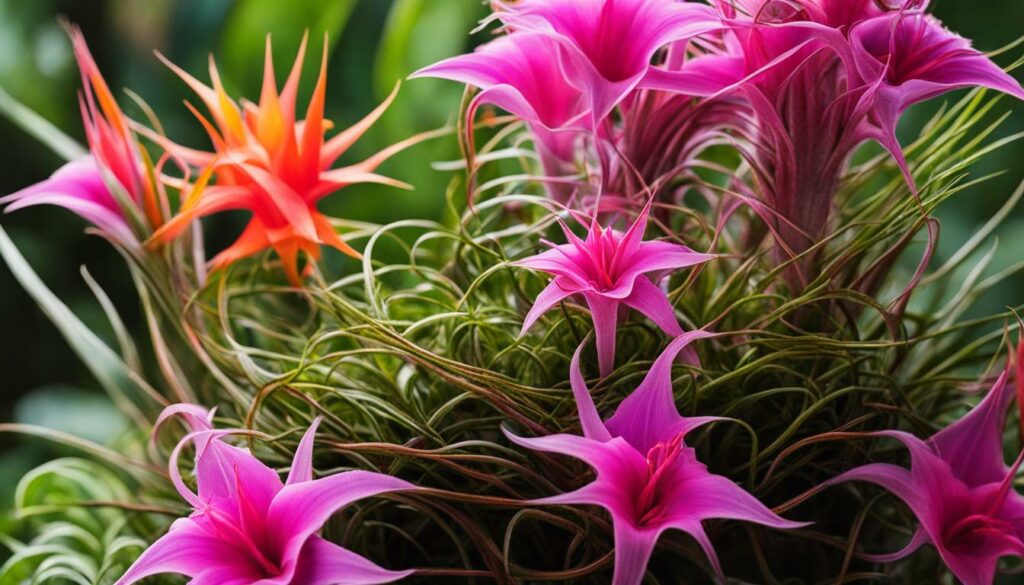
Ensure the well-being of your indoor terrarium plants, including Tillandsia air plants, by regularly monitoring for pests like mealybugs and scale insects, and addressing any issues promptly through effective troubleshooting and isolation methods.
Mealybugs and scale insects are common pests that can infest air plants in a terrarium. Mealybugs are small, white, cottony pests that feed on the sap of plants. They can be found on the leaves, stems, and flowers of air plants. Scale insects, on the other hand, are small, armoured pests that attach themselves to the leaves and stems of plants, sucking out the plant’s juices. Both pests can cause damage to the air plants if left untreated.
To treat a mealybug or scale insect infestation, start by isolating the affected air plant from the rest of the terrarium to prevent the pests from spreading. Gently remove the pests from the air plant by wiping them off with a cotton swab soaked in rubbing alcohol. For severe infestations, you may need to use an insecticidal soap or neem oil spray to control the pests. Be sure to follow the instructions on the product label carefully.
Preventive measures, such as regularly inspecting your air plants for signs of pests and keeping them in optimal growing conditions, can help minimize the risk of infestations. Additionally, avoid overwatering your terrarium as excessive moisture can create a favorable environment for pests. Providing proper air circulation by opening the terrarium periodically can also help prevent pest infestations.
| Pest | Symptoms | Treatment |
|---|---|---|
| Mealybugs | – White, cottony webbing on leaves – Sticky residue on leaves and surrounding area – Stunted growth | – Isolate the affected plant – Remove mealybugs manually with rubbing alcohol – Insecticidal soap or neem oil spray |
| Scale Insects | – Small, armoured, brown or black bumps on leaves – Yellowing or wilting leaves – Sticky residue on leaves and surrounding area | – Isolate the affected plant – Scrape off scale insects with a soft brush or cotton swab – Insecticidal soap or neem oil spray |
Regularly inspecting your air plants, addressing any pest issues promptly, and providing proper care will help ensure the health and vitality of your indoor terrarium plants, including Tillandsia air plants.
Quote:
“Pest infestations can be detrimental to the health of your air plants. It is important to monitor for pests regularly and take immediate action to prevent the spread and potential damage caused by mealybugs and scale insects.” – Indoor Plant Care Expert
Conclusion
In conclusion, Terrarium Plants Tillandsia air plants offer a captivating and low-maintenance option for creating lush, thriving indoor ecosystems, and this comprehensive guide has provided the essentials for successfully incorporating these unique plants into your terrarium.
Air plants, also known as Tillandsia, are perfect for terrariums due to their minimal care requirements and ability to thrive in various design setups. Whether you prefer a hanging terrarium or a wall-mounted display, these versatile plants will add beauty and elegance to any indoor space.
When selecting air plants for your terrarium, consider species that stay small and compact, such as the Tillandsia Ionantha or Tillandsia Mexican. These plants are ideal for limited spaces and require little maintenance, making them perfect for busy individuals or those new to terrarium gardening.
It’s crucial to create a suitable environment for your air plants within the terrarium. Ensure that the glass container allows for proper airflow and has clear glass to maximize light exposure. Additionally, the terrarium base can be crafted using materials like sand, gravel, or moss to provide a stable foundation for the air plants to thrive.
To enhance the aesthetic of your terrarium, consider incorporating decorative elements such as driftwood, shells, or crystals. These additions will add visual interest and create a personalized display unique to your style and taste.
Proper placement and securing of the air plants within the terrarium are essential for their health and growth. Avoid overcrowding and use glue or wire if necessary to keep the plants securely in place. Regular misting or soaking will keep the air plants hydrated, and monthly fertilization will provide them with the necessary nutrients for optimal growth.
Propagation of air plants can be done by separating the pups or offshoots that grow at the base of the mother plant. This allows you to expand your collection and create a thriving ecosystem within your terrarium.
Keep an eye out for common pests like mealybugs and scale insects, and promptly address any issues to maintain the health of your air plants. Regular monitoring, isolation of affected plants, and proper care will ensure the longevity and vibrancy of the indoor terrarium ecosystem.
Incorporate Terrarium Plants Tillandsia air plants into your home or office to create a tranquil and visually stunning space. With their captivating beauty and minimal care requirements, these unique plants are the perfect choice for anyone seeking an indoor garden that is both low-maintenance and visually rewarding.
Can Mosses and Tillandsia Air Plants Coexist in the Same Terrarium?
Yes, mosses and Tillandsia air plants can coexist in the same terrarium if given the ultimate terrarium plant care. Both plants thrive in high humidity and low light conditions, making them compatible terrarium companions. Regular misting, good air circulation, and proper drainage are essential for their optimal growth.
FAQ
Can air plants be grown in terrariums?
Yes, air plants, also known as Tillandsia, can be grown in terrariums.
What types of air plants are suitable for terrariums?
It is important to choose air plant species that stay small, such as Tillandsia Ionantha or Tillandsia Mexican, for terrariums.
What kind of container should I use for a terrarium?
A terrarium for air plants should have a glass container with good airflow and clear glass to allow for maximum light exposure.
What materials can be used for the base of a terrarium?
The base of a terrarium can be made with materials like sand, gravel, or moss.
Can I add decorations to my terrarium?
Yes, decorations such as driftwood, shells, or crystals can be added to enhance the aesthetic of the terrarium.
How should I secure the air plants in the terrarium?
When placing air plants in the terrarium, it is important to avoid overcrowding and secure them with glue or wire if necessary.
How do I care for air plants in a terrarium?
Air plants require regular misting or soaking to keep them hydrated, and they should be fertilized once a month.
How can I propagate air plants in a terrarium?
Air plants can be propagated by separating the pups, or offshoots, that grow at the base of the plant.
What should I do if my air plants are affected by pests?
It is important to monitor for pests like mealybugs and scale insects and isolate affected plants if necessary.
Where can I buy healthy air plants for my terrarium?
Healthy air plants can be purchased from reputable sources online.

